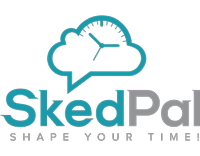On Monday, I attended an inspiring training day at the University of Southern Queensland, run by the Office for the Advancement of Learning and Teaching. I came away with a head full of ideas on how to improve my courses and to teach generally. One small idea I look forward to trialling is setting up a formative quiz at the beginning of the semester to gauge students’ starting level of knowledge. This also has the ancillary benefit of encouraging students to engage with Moodle early in the topic. I’ll report on the results!
A colleague and I were asked to share our task management/planning strategies with the group. I’ve been using SkedPal for the last six months or so, and I think it offers some unique and powerful features that are particularly useful for academics, which I shared with the group.
SkedPal combines task management/to-do lists with your calendar. Once you link your Outlook or Google calendar, your tasks are scheduled around your calendar appointments. This is great for people who do not want to rely on their willpower or spend time throughout their day deciding what to do next — its already been cleverly scheduled for you! You estimate how long a task will take and SkedPal finds a gap in your calendar. But where SkedPal sets itself apart from other time management/to-do apps is through its use of ‘time maps’.
Time maps allow the user to designate blocks of time to certain tasks throughout their week. Every task is allocated to one or more time maps. For example, one of my time maps is called ‘writing’, and this covers Monday through to Friday, from 9-11am. Any tasks assigned to this ’time map’ will be scheduled for that period. Here is a look at my ‘writing’ time map.

You can also specify times when it would be less desirable to work on this set of tasks, but you are willing to do it. I find this particularly useful for when I have multiple deadlines (marking, teaching, publishing) and my work hours are extended. Below is my default ‘work’ time map. This shows that most tasks will be scheduled from 11-6:30 pm, with a break for lunch. The orange time blocks are where tasks can be scheduled if they need to be. I also have an early morning time map if I need it.

I am in the final stages of completing my PhD, so anything related to my thesis is assigned to my writing time map. This means every day I know I have at least 2 hours I spend on my thesis. If there is not enough room for a particular task to be scheduled on a given day, then it will be scheduled to another day where there is a gap in my calendar. You can ensure a task is completed today by setting the due date as today. Giving it a ‘high priority’ flag will also promote this task over non-flagged tasks.
You might be concerned that having a calendar full all the time will make it hard for colleagues to schedule appointments. But there is a setting that allows all SkedPal tasks to appear as either ‘busy’ or ‘available’.
Other features include:
- You can automatically schedule a time buffer between tasks. Either as a fixed figure or as a percentage of the duration of the task, which is great in case something takes you longer than expected. If things go off the rails (e.g. unexpected meeting), you can always click reschedule and SkedPal will replan your day, based on your priorities, due dates and time maps.
- You can always click and drag tasks to manual reschedule them and they remain ‘pinned’ to that time even when you click reschedule.
- It is possible to partially complete large tasks, which may get split-up throughout your day (although you can specify the minimum block length, i.e. you don’t want to spend less than 1 hour or 30 minutes on a larger task). When you partially complete a task, when you reschedule your day the 1-hour’s work you completed on a 3-hour task is not ignored.
If you are struggling to find more time to write, I encourage you to consider SkedPal. They are currently offering a 14-day free trial, so you can try it risk-free and see if it works for you. It is available on Mac, Windows, Linux, iOS and Google Play. SkedPal is cloud-based, so all your apps sync in real time as well!
If you have any questions about how I use SkedPal, post them below. Likewise, I would like to hear what works for you. Do you use a lot of time maps or only a few?




